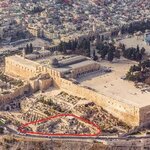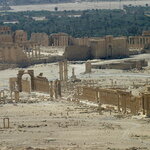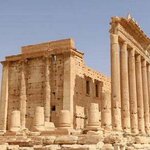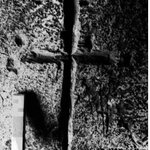Archaeology

The modern definition of science could be stated that it is
a systematic study of the natural world through the scientific method. This means creating a hypothesis and testing
it to determine the extent to which it can explain measurement results. A common notion is that science facts are
truth but in reality, not everybody in society (or even science) really agrees
about the meaning of truth. As a matter
of observation, it should be said that it does not matter whether you believe
gravity is real or agree with the laws of thermodynamics or electrodynamics. In…

The Ophel excavations at the foot of the southern wall of the Temple Mount have unearthed an impression of the royal seal of King Hezekiah, around 727-698 B.C.
Measuring 9.7 X 8.6 mm, the oval impression was imprinted on a 3 mm thick soft bulla (piece of inscribed clay) measuring 13 X 12 mm. Around the impression is the depression left by the frame of the ring in which the seal was set.
The impression bears an inscription in ancient Hebrew script: "Belonging to Hezekiah [son of] Ahaz king of Judah," and a two-winged sun, with wings turned downward, flanked by two ankh symbols…

Giants once roamed the earth. Oceans teemed with ninety-foot-long whales, huge land animals ate vast quantities of food and, yes, deposited vast quantities of poop.
A new study shows that these whales and outsized land mammals, as well as seabirds and migrating fish, played a vital role in keeping the planet fertile by transporting nutrients from ocean depths and spreading them across seas, up rivers, and deep inland, even to mountaintops.
However, massive declines and extinctions of many of these animals has deeply damaged this planetary nutrient recycling system, a team of scientists…

In nutrition, the saying goes, 'in the old days you had to be rich to be fat, now you have to be rich to be thin.'
We have a biological mandate to try and ride out food booms and busts by consuming as many calories as we can, when we can. Rich people can take that out of their hands by paying for people to tell them to exercise and what not to eat and so they won't get gout like they once did. Poor people, with less disposable income, will shop for calorically-dense foods.
It isn't just the food that was once unhealthy. Anti-science environmentalists can trump up controversy about…

In Thessaloniki for a greek weekend and a wedding, I had a chance this morning to visit the city's archaeological museum. I was not expecting much, although I had a vague recollection that the area is rich with old archaeological sites and tombs, many of which were unearthed in pristine state. Hence I was extremely happy of the wealth of sculptures, jewelry, vases, and objects of all kinds, especially ones from the pre-Ellenistic period.The collection of jewelry and gold and silver coins was impressive; by itself it was well worth the visit. But two things really made my day: some incredibly…

There has been much public condemnation of the destruction of the Temple of Bel at Palmyra by Islamic State (IS), as well as the wider devastation being inflicted on the cultural heritage of Syria and Iraq by both IS and its opponents in Syria’s civil war.
Both Syria and Iraq are party to all relevant treaties protecting cultural heritage, but this has not stopped the rampant violations. This implies that the problem doesn’t lie with inadequate laws, but rather with compliance and enforcement.
This is not just a matter for states involved in conflict. A major problem with the international…

Images of the systematic destruction of archaeological sites and art pieces in Syria are no news any more, but I was especially saddened to see before/after aerial pictures of Palmyra's site today, which demonstrate how the beautiful temple of Bel has been completely destroyed by explosives. A picture of the temple is shown below.
Before I lament this latest loss, however, let me get one thing straight: as much as I love art and art history, I think we give too much importance to these acts of vandalism in our media, compared to the almost null attention we pay to the daily tragedies of…

Archaeologists have found evidence of an ancient gold trade route between the south-west of the UK and Ireland, which would mean people were trading gold between the two countries as far back as the early Bronze Age, 2500 B.C.
The finding was made after measuring the chemical composition of early gold artifacts in Ireland and discovering that the objects were actually made from imported gold, rather than Irish. The gold is most likely to have come from Cornwall, which means the symbiotic link between Ireland and England is even farther back then believed.
Lunula and discs. Credit…

Remarkably similar carvings and simple cross sculptures mark special sites or places once sacred, spanning a zone stretching from the Irish and Scottish coasts to Iceland. We can look to Skellig Michael, which rises from the sea 12 kilometers off the southwest Irish coast; to Aird a’Mhòrain on the Outer Hebridean island of North Uist; to the Isle of Noss, Shetland; and to Heimaklettur cliff face in Iceland’s Westman Islands.
Also in southern Iceland, a number of the 200 man-made caves found there are marked by similar rock-cut sculpture. And these dark remote places suggest a different answer…

If you like mummies (and who doesn't like mummies?) you are in luck: The Anatomical Record has a special issue with 26 articles devoted to them, all open access. You may not leave the house this weekend.
The issue takes an "integrative anatomy" approach, looking at mummies from the inside and outside using methodologies from physiology, molecular biology, and cell biology along with the more traditional dissection, histology, or histochemistry. One article mummifies modern tissue using ancient techniques, for example, while others deals with mummies from various regions. They are…